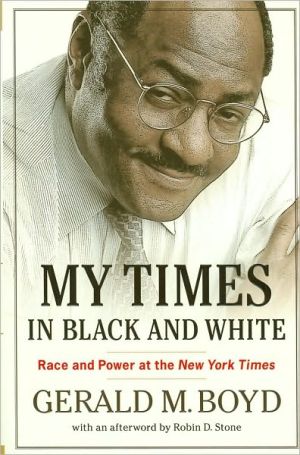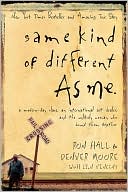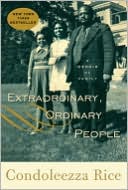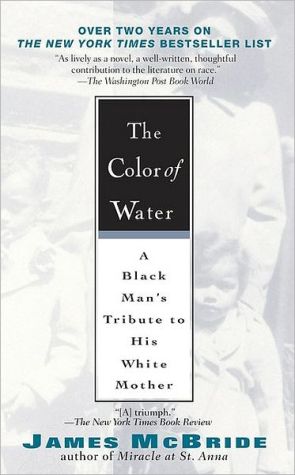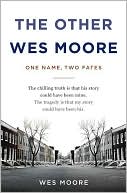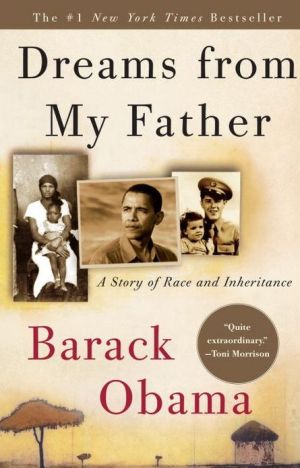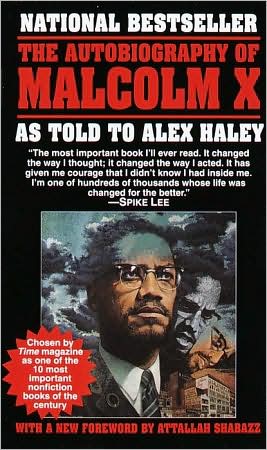My Times in Black and White: Race and Power at The New York Times
“An inspiring and riveting tale.” —Patrik Henry Bass, Senior Editor, Essence\ \ After a career of many firsts, journalist Gerald Boyd became the first black managing editor of the New York Times. But the dream ended abruptly with Boyd’s forced resignation in the wake of scandal over Jayson Blair, a reporter who had plagiarized and fabricated news stories.\ \ A rare inside view of power and behind-the-scenes politics at the nation’s premier newspaper, My Times in Black and White is...
Search in google:
“An inspiring and riveting tale.” —Patrik Henry Bass, Senior Editor, Essence After a career of many firsts, journalist Gerald Boyd became the first black managing editor of the New York Times. But the dream ended abruptly with Boyd’s forced resignation in the wake of scandal over Jayson Blair, a reporter who had plagiarized and fabricated news stories. A rare inside view of power and behind-the-scenes politics at the nation’s premier newspaper, My Times in Black and White is the inspirational tale of a man who rose from urban poverty to the top of his field, struggling against whitedominated media, tearing down racial barriers, and all the while documenting the most extraordinary events of the latter twentieth century.The Washington Post - Kim McLarinA skeptic—or just a good reporter—might find it hard to accept that a man who climbed as high at the politically driven Times could be as guileless as Boyd portrays himself. But this memoir is not meant as a deep character study. Had Boyd lived and gained more distance, he might have written a more self-probing book. This is a reclamation project, and as such it largely succeeds.
MY TIMES IN BLACK AND WHITE\ Race and Power at the New York Times \ \ By GERALD M. BOYD \ Lawrence Hill Books\ Copyright © 2010 Robin D. Stone\ All right reserved. \ ISBN: 978-1-55652-952-8 \ \ \ \ Chapter One\ LOSS AND LOVE \ * * *\ When did Gerald become cool? When we worked together on Soldan High's newspaper and he reproached me for being "too emotional" an editor-in-chief, I didn't think he was cool. When he went to Mizzou, I thought Gerald was worthy, but I didn't think he was cool. I felt he was too serious, and wondered if college would help him lighten up and make cool friends. When he arrived very late for a party I threw for him and my then-husband (in the 80s; they shared an October birth date), Gerald was in some kind of funk, and I didn't think he was cool. It was a party, dammit. Months had passed without a word. Was it so hard for him to be ... well, nice? To be cool? When I saw him last in 2004 on a bright Sunday morning, it was the final hours of a weekend in St. Louis at our Soldan class's thirty-fifth reunion. He sat alone in a restaurant booth, his cherished Times before him, and suddenly, Gerald was cool. Today I find comfort in those reunion memories: the warm hug between Gerald and my husband, Larry, upon their first meeting on Friday; Gerald'sheartfelt keynote speech infused with love for Robin, Zachary, and journalism on Saturday; our tender farewell at breakfast on Sunday. The Gerald Michael Boyd I knew, scolded, and loved for more than forty years could be frustrating, stubborn, distant, provocative, and a bad dancer even on the slow songs. But you know what? My friend was so cool. -JACKI (GREEN) MOFFI\ * * *\ We buried my mother on a clear, frigid January morning in 1954. She wore a white dress that matched her casket. To the left of the casket lay a flower arrangement with a clock set at four, the time she died one morning the week before. The death certificate listed her as a female Negro and a housewife. It said her stillborn baby was at eight months' gestation and that my mother was felled by cerebral thrombosis, or a blood clot in her brain. Pregnant women have a higher risk for forming blood clots, and Odessa Thomas Boyd, who had acute anemia, was carrying her fourth child.\ My sister never received a name, which was, I suppose, acknowledgment of how fragile we were as a family. Another loss would be too much to bear, and naming the baby would only make that loss more real.\ We sat in the front row at Ellis Funeral Home on Stoddard Street in central St. Louis, I have been told: my father, Rufus, and his three children. The choir sang sacred standards, "Amazing Grace" and "Nearer, My God, to Thee." My uncle Clarence and his band ended the service with "Until We Meet Again." I slept through most of the somber proceedings, comfortable on my aunt Laura's lap. If I had been awake, I would not have known what to make of it all. I was three years old.\ None of it registered with my younger sister, Ruth, either. Only my brother, Gary, who was seven, was able to grasp the meaning of losing his mother. He knew she was never coming back.\ Try as I might, my memories were not strong enough to keep her with me. No kisses good night, no tuck-ins, no hugs, no gentle wipes to clear a spot of jam from my chin. I never knew my mother, not in the way most children do. We did not spend our evenings on the living room sofa listening to stories about how she met and fell in love with my father. I do not remember her laughter around the kitchen table at dinnertime, or her voice at all for that matter, or any of the treasured moments that more fortunate adults replay from childhood.\ The few fleeting glimpses I am lucky enough to have of my mother -if you can call it luck-haunt me. I see them as if I am staring hard through a waterlogged lens. At times, I can almost picture the vague form of her face, but long before the scene crystallizes, it disappears again.\ Though I could not see her and could not feel her, as I grew up I would imagine that she was with me. My mother was my secret weapon, this angel who watched over me and argued with the rest of the angels on my behalf.\ Odessa came to rest that cold morning in Booker T. Washington, a segregated cemetery across the Mississippi River in East St. Louis. Grave 6, Row 2, Lot 2. And when we put her in the ground, we buried much of my childhood. Losing her has been a taint on my life, a stain throughout my years, in ways that I came to grasp only late in adulthood.\ She died six months shy of her twenty-seventh birthday. It was amazing that she had seen twenty-six. Throughout childhood, she suffered from what was most likely sickle cell anemia, a malformation of red blood cells that impaired her body's ability to absorb oxygen from her lungs. She learned to live with the agonizing pains in her joints, the fatigue and nausea, the headaches, the shortness of breath. She also tolerated infections and a persistent sore on one of her thin legs that, no matter how much liniment she put on it, never healed.\ There were the constant trips to the hospital for transfusions to boost her healthy red blood cell count. She had been punctured and pricked and probed by so many needles that, over the years, doctors and nurses could barely find a vein that was not near collapse. With fresh blood coursing through her, Odessa would lie in a hospital bed for days or even weeks until she regained enough strength to return home.\ When she was home, relatives told me, Odessa tried to be the best mother and wife she could be. She cooked and kept a tidy house when she was able. No matter how tired or weak she was, she still doted on us children, smothering us with hugs and kisses. She so wanted another daughter to make her family complete.\ Becoming pregnant again was extremely dangerous for a woman with her compromised organs. How could she ever sustain a growing fetus? Odessa's weakened system could barely support her, let alone any baby she carried. Each of her pregnancies had taxed her body more than the previous one. Doctors warned her that she was flirting with death. They urged her to have her tubes tied, an option she rejected outright.\ And she never complained. "I was worried and so were others," my aunt Laura recalled. "But not Odessa." Perhaps she was resigned to her fate, Aunt Laura said. "She once said to me, 'I'm not going to get well anyway.'"\ * * *\ ODESSA AND Rufus met in 1946 in St. Louis, one of the dozens of northern cities receiving an infusion of southern, rural blacks. Their experience mirrors that of hundreds of thousands who were part of the Great Migration, one of the most significant movements of the twentieth century. The migrants shaped not only the cultural, political, and social fabric of urban areas but also black culture as a whole, adapting southern traditions to a northern lifestyle to create thriving communities that influenced everything from employment to the arts. The relocated relatives clustered around one another in the city. Uncles, aunts, and cousins lived across the street or a block or two away, flowing freely from house to house.\ Odessa was a tall, slender country girl with smooth cocoa skin and deeper brown eyes. She was a looker, as fine women were called then, feisty and sweet-she drew young men like flies to honey. She was soft-spoken and a great listener who loved to sing in low soprano and dance to the latest pop songs. Though she was quiet, she was not afraid to speak her mind. She had a streak of stubborn determination with which she pursued anything she wanted. And she wanted Rufus, who was solid, dependable, and worldly, having gone overseas in the navy in World War II.\ At three years Odessa's senior, Rufus was quite mature and charming, especially when he put on his suits and the attitude that went with them. He also was known as a man who liked his drink. He was not a cruel or abusive drunk, and unless you studied him closely, it was difficult to determine when he had had too much. There was no doubt that he was madly in love with Odessa.\ They dated by slipping off to the movies or popular St. Louis nightclubs like the Riviera, where they listened to Lionel Hampton or Duke Ellington. When the club scene became too rowdy, they hung out with friends, playing cards on weekends. Mostly they spent time just talking in the yards in front of their homes, where my father would impress my mother with his countless stories about how people lived in lands far away.\ Rufus and Odessa married the same year they met, in a small ceremony at the home of a minister. They were simple people, my parents, and wanted nothing more than to make a life for themselves and the family they hoped to have. Like most of the migrants, both grew up on farms, and the paths that brought them north were quite similar. St. Louis was a world removed from the fields and farms where the Southern transplants had barely eked out an existence, where they were still beating back Jim Crow, where the change of the seasons dictated the rhythm of life. Another thing my parents had in common: they were both poor.\ Rufus was not yet eighteen in 1941, when the War Department found him deep in the small Mississippi Delta town of Itta Bena in Leflore County, where he had been sweating alongside his parents, brothers and sisters, cousins, uncles, aunts, and grandparents in the fertile cotton fields that governed their lives. For his family as for so many others, life had two realities-little money and a load of kinfolk.\ My parents' individual family histories are similar to those of many other black families shaped by the African diaspora and slavery. The Delta that Rufus abandoned to become a navy cook had been home to his family for more than one hundred years. Jacob and Betsy, his great-great grandparents, were enslaved on a plantation there in 1819. They took the last name of the owner, a man called Waits. The sale of Jacob and Betsy's son Jake, along with other children of enslaved parents, was recorded by a white man in a worn and dusty book in the Leflore County courthouse: "I warrant that they are sound and healthy and free from disease and slaves for life."\ When emancipation came, Jacob and Betsy's children stayed around Itta Bena working the land. Jake, unlike many slaves separated from their parents, had not traveled far. He and his wife, Katie, produced thirteen children-seven boys and six girls. Their youngest, Evie (or Eva-she spelled it both ways), who was born May 9, 1897, was my grandmother.\ Jake, my great-grandfather, was known as Big Jake to distinguish him from his son and because of his imposing stature. Tall and dark, proud and robust, he rode around his ten-acre farm astride a brown horse, with a thick cigar dangling from his mouth. He was self-sufficient, working the land, saving his money. Eventually, he managed to buy a patch of property that he and his family worked, then another, then another. Even through the Great Depression, his family held tight because the farm produced almost everything they needed. The rich Delta soil yielded an abundance of corn, sweet and white potatoes, sugarcane, and all kinds of greens. Cows gave them milk, butter, and meat. From hogs, the family got hams at Christmas and the pork niblets for the cracklin' bread they ate regularly. What they did not eat in season, they pickled or preserved or salted away for later.\ September, the time for picking cotton, was one of the most brutal months but also the most rewarding. The whole family joined in the harvest-from children to the oldest of the elders. With burlap sacks over their shoulders, they tugged at the bulbs gingerly to keep from getting cut by long needles that could be sharper than sharp. From this and the pecans they planted and grew, Big Jake put away enough to carry his family through the winters.\ Eventually, Jake Waits owned enough land for almost all of his children, including my grandmother, to build their own houses. As a lord of the manor, every few days Jake would ride from home to home, paying each of his children a brief visit and making sure they were all right.\ In 1920, Jake and Katie's baby girl, Evie, a tiny woman who topped out at five feet tall, met and married a man named Charles Boyd. They built a house close to the main house, the big house where Jake lived. By all descriptions, Evie's place was not much to look at, with its simple wooden floors and small rooms. But like all of the homes, it was clean, with neatly pressed sheets on the beds and fresh linen on the kitchen table.\ A year after they married, Evie and Charles had their first child, a boy named Robert, who was born on the Fourth of July. Four more babies followed: Katie Mae; Larry; my father, Rufus; and Bertha.\ But Evie was walking a tightrope. Charles was "a mean man," she once said, leaving it at that. He was a wanderer, leaving the house for destinations unknown and returning whenever it suited him. One day, he came home and watched my grandmother combing one of the girls' hair, and suddenly and without explanation, he grabbed the comb from her hand, threw it into the yard, and walked off. She never saw him again. Whenever people asked about a husband, she replied simply that she was widowed. My grandmother would later have a couple of male "friends," but she never remarried.\ With an extended family so nearby, Evie, a single mother of five, found ready support. Her three boys grew up in the house with her, while the two girls lived in the big house under the watchful eye of Grandmother Katie. Evie and her brood did almost everything with her sisters and brothers, especially on Sundays, when the entire family filed into the same African Methodist Episcopal church. They spent the day in worship and followed that with more fellowship and feasting. Each family brought a dish or two to share in a communal repast.\ Then came the Great Depression. Jake lost Katie. He remarried and in 1935 became ill with pneumonia. When he died that same year, he left behind thirteen children and dozens of grandchildren. He also left the land to his family, but they did not hold it for long.\ Several of my grandmother's brothers moved to Jackson, Mississippi's capital, where they bought a plot of land large enough to build several houses. Evie, just past thirty, remained in Itta Bena on what was left of the farm, trying to hold on to her land. With sadness, she would later describe how unscrupulous whites swindled the family out of one acre after another.\ With her three sons in the military, and one daughter, Katie Mae, married and living in St. Louis, my grandmother, alone and weary from struggling over land, decided to leave Mississippi altogether. She headed north to live with her daughter and son-in-law, figuring she could make a living doing housework for white people. It was drudgery but one of the few options available for a black woman with more farm than formal education. And anyhow, the wages would be considerably higher than what she could make in Mississippi.\ She headed up Highway 7 through Greenville to Interstate 55, following that through Memphis and on to St. Louis. Under the rules and rigors of Jim Crow, colored travelers knew not to stop their cars along the highways and to pack whatever food they wanted to eat, because they would not be served along the way.\ For a farming woman from small-town Mississippi, St. Louis had to be overwhelming. It counted more than eight hundred thousand residents. Streets swarmed with cars and people, and blacks filed off the highways and out of the train depots into slums that were already brimming with new transplants. Jobs were plentiful in huge plants producing everything from beer to bricks, from shoes to steel. But not everybody found work, and in close quarters, crime and illness were on the rise.\ Odessa's lineage had a similar profile. She too grew up on a farm, in a small Arkansas town called Camden. It was owned by her grandmother, Fronia Evans Turner, a striking woman, with long straight hair and high cheekbones, born in 1885 somewhere in Oklahoma. While in Oklahoma, she met and married a man with the last name of Thomas. They had one child, my grandfather Elige, who in 1922 married Georgia McDuffie Wilson and settled into life on the farm that Fronia owned, growing cotton and corn, and having and raising children. In 1923, a year after their wedding, Georgia bore a daughter, Laura Bell. Two years later, my mother, Odessa, was born. Georgia's third girl, Dorothy Lee, died in infancy the next year. Two boys followed: Clarence in 1928 and John Henry in 1931.\ (Continues...)\ \ \ \ \ Excerpted from MY TIMES IN BLACK AND WHITE by GERALD M. BOYD Copyright © 2010 by Robin D. Stone. Excerpted by permission.\ All rights reserved. No part of this excerpt may be reproduced or reprinted without permission in writing from the publisher.\ Excerpts are provided by Dial-A-Book Inc. solely for the personal use of visitors to this web site. \ \
Prologue: "This Is Really Hard" 31 Loss and Love 152 Seeds of Ambition 393 From Uganda X to Cub Reporter 594 Growing but Restless 815 Fresh Starts 1036 D.C. Grind 1217 Fast Tracked 1538 My Times 1779 Shifting Priorities and Alliances 20110 Joy and Heartbreak 21511 The Outsiders 23312 The Greatest Story 25513 Managing Up, Managing Down 27114 The Makings of a Scandal 29315 Inquisition 31516 Free Fail 33317 A Time for Good-byes 359Afterword Robin D.Stone Stone, Robin D. 383Postscript 389Contributors 391Index 393
\ Kim McLarinA skeptic—or just a good reporter—might find it hard to accept that a man who climbed as high at the politically driven Times could be as guileless as Boyd portrays himself. But this memoir is not meant as a deep character study. Had Boyd lived and gained more distance, he might have written a more self-probing book. This is a reclamation project, and as such it largely succeeds.\ —The Washington Post\ \ \ \ \ Publishers WeeklyBoyd's appointment to the role of managing editor of the New York Times in 2001 made him the first African-American to hold one of the paper's top two editing positions, and his leadership helped the Times garner numerous Pulitzers. But colleagues found him gruff and imposing—a perception he attributed to racial bias—and he was forced to resign after a young reporter named Jayson Blair was caught plagiarizing and fabricating stories in 2003. In this memoir, Boyd, who died in 2006, comes across as a relentlessly ambitious man who overcame poverty, racism, and a rocky personal life to become one of the most powerful newsmen of his day. Unfortunately, Boyd proves to be a merely competent narrator: the prose is smooth but lacks flair, and the vignettes themselves are disappointingly dry. The notable exception is the treatment of the Blair scandal: Boyd's blow-by-blow is animated by indignation and gives a rare glimpse into the rancorous world of newsroom politics. Although as a source of objective truth the memoir is more suspect than a news story, Boyd's perspective is crucial to understanding the crisis that unfolded at the Times in 2003. (Feb.)\ \ \ Kirkus ReviewsPosthumous memoir of the first African-American managing editor of the New York Times. Boyd (1950-2006) was the youngest child in a poor St. Louis family, and his young mother died when he was three. The subsequent departure of his father caused the feelings of "fatalism" that would saturate his early adulthood. Raised by his stern yet loving grandmother, Boyd sought guidance and protection from his older brother, a cousin and, during his teens, the Coopers, a compassionate Jewish family. Through forced bussing and the assassination of Martin Luther King Jr., Boyd emerged impassioned by writing and was awarded a scholarship to the University of Missouri, along with a copyboy job at the St. Louis Post-Dispatch. As his confidence and professional acumen grew-along with his awareness of "openly racist attitudes and slights"-he fell in love with and married Sheila, a fellow writer. Though the marriage dissolved years later, Boyd's career blossomed-first as a White House correspondent, followed by years of laborious, racially challenging ladder-climbing he calls "the ugly underside of life at the Times." The author's courageous fight for racial equality both inside and outside the workplace never ceased, and he smartly remarks that in America's newsrooms, African-Americans "have been tolerated but rarely embraced." Eventually the fact-heavy text becomes consumed with episodes of newsroom drama, including his love/hate relationship with the Times' "pragmatic" executive editor Howell Raines. After remarrying and starting a family, Boyd's bubble burst with his involuntary resignation following the fallout from the Jayson Blair plagiarism scandal in 2003. Photographs and chapters prefaced byanecdotal commentary from peers and friends add integrity to a comprehensive, noteworthy memoir. An important, culturally sensitive portrait of success, failure and atonement.\ \
